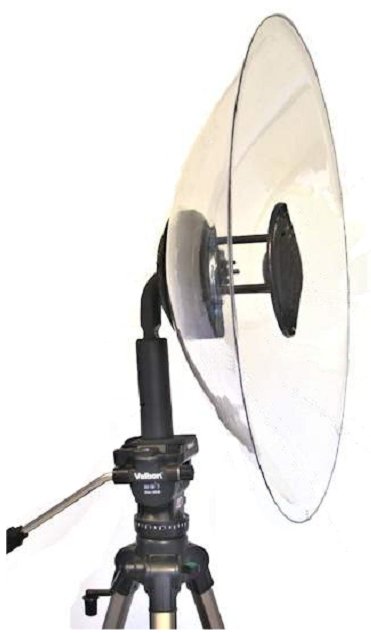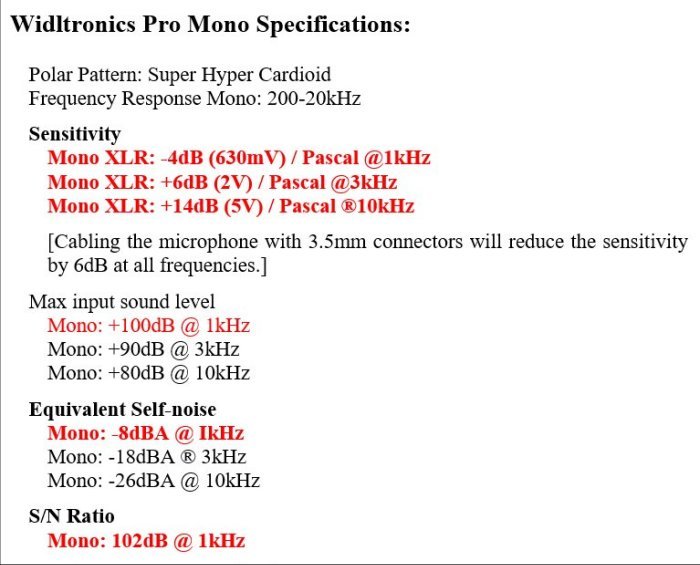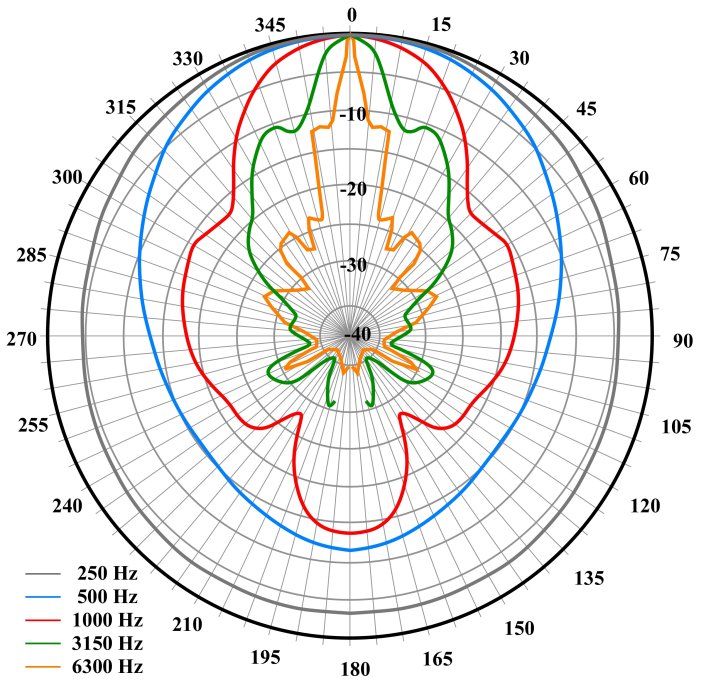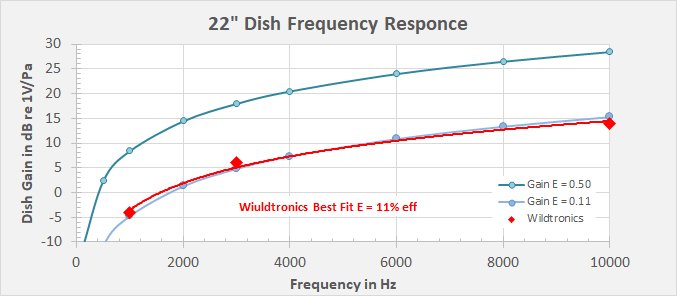
 |
 Description from the Wildtronics website:
Description from the Wildtronics website:
The Wildtronics Parabolic Microphone is engineered to the be the most advanced and best performing parabolic microphone on the market. The microphone was developed by Bruce Rutkoski, who has professionally recorded nature sounds for over a dozen years, originated new recording techniques, and has designed many specialized recording devices. This microphone offers the professional a vastly improved parabolic microphone, with multiple connectivity without special cables, an integral tripod mount, accessory mounting provisions, and costs a fraction of competing microphones. The new, original design combines multiple techniques to increase audio gain, broaden the frequency response, reduce mic self-noise, improve isolation of the subject, and minimize handling noise. Use this parabolic microphone for sound reinforcement on football and baseball fields, recording birds and nature sounds, wildlife research, law enforcement, paranormal investigation, or anytime sounds need to amplified and isolated beyond the performance of other microphones.
The large, 22-inch, parabolic dish is optimally sized to balance portability and low frequency response. The dish is clear so you may accurately sight your target. Parabolic curves can be calculated to select the depth and focal point. The Wildtronics' parabolic shape was optimized for a focal point to match the microphone's polar response, shield undesired sound pickup, and offer a compact package. The paraboloid was then accurately CNC machined to create a master mold. This accuracy is necessary for precision focus at higher frequencies. The microphone assembly is easily removed and reinstalled without altering it's precisely located, factory set focal point. The molded plastic dish is 0.080-inch thick for best all around durability, critical shape retention, and some bending to fit into larger airline luggage.
Integral booster discs are designed into the microphone assembly to increase the audio gain, boost low frequency response to that of a 30-inch parabolic dish, and help isolate the sound pickup to only the focused target and avoid other stray sounds. This amazing booster disc technology further sets the Wildtronics Parabolic Microphone apart from all others.
Not just one, but an array of low noise microphone elements are used at the focal point of the parabola. Array technology not only increases the audio gain, but reduces self noise to that of the lowest noise microphones on the market. Combined with the parabolic dish and booster discs, the signal to noise ratio is far higher than any other microphone. A military grade foam windscreen is built-in.
There are no special or custom cables needed to connect the Wildtronics Parabolic Microphone to your amplifiers or recorders. Both standard, balanced XLR and 3.5mm connectors are conveniently located on the back panel. You can use 11-53 volt phantom power or the internal 9-volt battery. 9-volt battery life is about 150 hours, so you can save battery life in your other equipment by turning off it's phantom power.
The entire microphone assembly is engineered to reduce the effects of handling noise and inadvertent bumps. A special foam suspension system helps isolate the microphone assembly from handling noise. In addition, the comfortable, foam handle grip was carefully selected with a texture that minimizes noise from hand movements.
The lightweight aluminum alloy parts are powder coated for durability. A black, low reflectivity finish is used throughout to increase stealth. A 1/4-20 thread, in the bottom of the solid high strength handle, allows easy attachment to a tripod. An optional Accessory Bar Kit is available that allows versatile mounting of additional equipment. With the Accessory Bar Kit, you can mount cameras, tripods, recorders, preamps, wireless transmitters, and install the included dual handles that give improved comfort and superb balance.
$790

Wildtronics Parabolic Microphone Technical:

My analysis starts here:
The following Frequency Responce chart was cobbled together with Wildtronics Sensitivity values overlain on the Dish Gain Equation for a 20.5 inch dish. The three sensitivity values allowed me to calculate a relationship of gain vs frequency defined thus: Wildtronics Dish Gain = 8.16 ln(frequency Hz) - 60.9. This relation most closely matches the Gain Equation for a 20.5 inch dish with 11% efficiency.

Gain dB = 20LOG(3.25DE/W) Where: D = diameter inches
W = wavelength inches
E = efficiency (0 to 1)
Does this actually mean the dish has only 11% efficiency? NOT so. The Pro Mono Sensitivity is the Sensitivity of the Array microphone boosted by the 22 (20.5) inch dish with a 6 inch boundary booster disk. The four components we need to know for the system sensitivity are: 1) dish gain, 2) dish efficiency, 3)booster gain, and 4) array microphone sensitivity. All numbers and computations in this analysis assume 1000 Hz frequency.
For the total system sensitivity we know the answer, it is -4.8 dB. Everything that follows is just showing off.
Note that until now I have been speaking in generalities, now I wish to make a few calculations. This means that I need to start with the fact that the Wildtronics dish effective diameter is 20.5 inches, not 22. That is because the diameter includes a 3/4 inch flange that does not enter into the dish gain equation. The Wildtronics website claims that the dish performs close to the theoretical maximum for a parabolic dish, that is a 13 dB gain at 1000 Hz. From the dish gain equation this corresponds to an efficiency of 90%! Sawant, O. and Bhowmick, IEEE, Jan 2022 suggest acoustic dish efficiency ranges between 45 and 70% so in the following evaluation I will go with 80% as a compromise. Given the total is -4.8 dB, its a zero-sum game, if the dish is to be more efficient, the microphone must be less sensitive.
Also published on the Wildtronics website is the information that the integrated booster disk makes the 22 (20.5) inch dish have the sensitivity of a 30 inch dish. For 1000 Hz at any dish efficiency the difference in gain between a 20.5 and a 30 inch dish is 3.3 dB. That is what the booster adds. The web site also suggests a 6 dB boost from the disk reflecting the boundary effect around the microphone. I note here that a full 6 dB boost would be as if the dish were 44 inches, not 30 so the booster benefit must be closer to the 3.3 dB, not 6.
To test the full range of possible microphone sensitivities I made a spreadsheet varying the dish efficiency from 70 to 90% and booster efficiency from 3.3 to 6.0 dB. End members are thus:
Max case: 70% dish eff and 3.3 dB boost = -18.1 dB mic sensitivity.
Min case: 90% dish eff and 6.0 dB boost = -22.3 dB mic sensitivity. The array mic sensitivity cannot be any lower than this.
It would be nice if Wildtronics just published the measured array microphone sensitivity.
A conservative model:
Total Sensitivity (-4.8 dB) = Dish 80% gain (11.9 dB) plus booster gain (3.3 dB) plus Microphone sensitivity (-20.0 dB) = -4.8 dB.
This neatly ties up everything I can glean from the Wildtronics website, at least all the numbers add up.
I need to add an additional consideration that has become important to my setup. I record 2 to 3 hours a day in a humid Gulf Coast environment. Humidity now prevents my original Rode NT1 from operating and I have since replaced it with a moisture-resistant Rode NTG5. The Wildtronics microphone array includes dehumidifying heaters and I have had NO problems whatsoever with humidity. I appreciate this attention to detail in the Wildtronics design.
I feel that the system Mr. Rutkoski has designed with integrated dish, booster, and array microphone is as good as any on the market, likely better than most.
KJS 04/2025